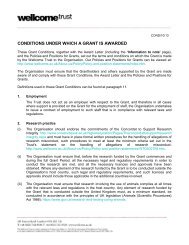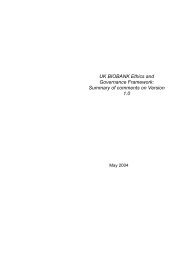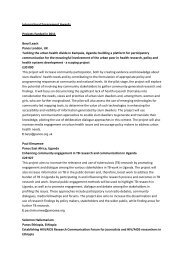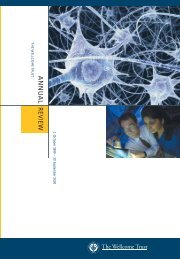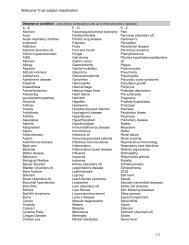Create successful ePaper yourself
Turn your PDF publications into a flip-book with our unique Google optimized e-Paper software.
34 | DEVELOPING PEOPLE<br />
A neglected<br />
malaria<br />
Once considered benign, vivax malaria is actually<br />
far from innocuous.<br />
Go with<br />
the flow<br />
Blood flow to the brain is carefully<br />
controlled – but in a surprising way.<br />
1<br />
As well as P. falciparum, other<br />
Plasmodium species can cause<br />
malaria, including P. vivax. Vivax<br />
malaria has been considered relatively<br />
harmless, but as Career Development<br />
Fellow Ric Price has discovered, it is<br />
common, serious and, with drugresistant<br />
forms appearing, a growing<br />
threat to health in South-east Asia.<br />
Malaria remains a serious problem in<br />
South-east Asia, accounting for 40 per<br />
cent of the world’s cases. Unlike Africa,<br />
where falciparum malaria predominates,<br />
South-east Asia faces infections from<br />
both P. falciparum and P. vivax.<br />
To test whether P. vivax really is ‘benign’,<br />
Dr Price at the Menzies School of Health<br />
Research in Australia, working with the<br />
<strong>Wellcome</strong> <strong>Trust</strong>’s South-east Asia<br />
Programme, set out to assess the impact<br />
of the two malarias in Papua, Indonesia.<br />
An analysis of hospital admissions over a<br />
four-year period revealed that 64 per cent<br />
of patients with malaria had P. falciparum,<br />
24 per cent P. vivax and 10.5 per cent<br />
mixed infections. In children under one,<br />
however, P. vivax accounted for nearly<br />
half of all malaria admissions. Across all<br />
ages, the death rate for P. vivax, 1.6 per<br />
cent, was comparable to the overall<br />
death rate from malaria (2 per cent).<br />
A community study revealed similar<br />
patterns. More than half of the population<br />
can expect to experience falciparum<br />
malaria each year and nearly a third vivax<br />
malaria. Again, the prevalence of vivax<br />
malaria was higher in young children.<br />
Moreover, vivax can also be harmful<br />
during pregnancy. In a separate study, Dr<br />
Price found that the fever and anaemia<br />
associated with vivax as well as<br />
falciparum malaria raised the risk of<br />
premature labour and stillbirth in<br />
pregnant women.<br />
In part, P. vivax has been neglected<br />
because drug resistance has been less of<br />
a problem – it first appeared as recently<br />
as 1989. Now, though, drug-resistant<br />
forms of P. vivax are spreading across<br />
much of South-east Asia and more<br />
recently in South America. Cure rates for<br />
standard treatments have fallen below<br />
half for both P. falciparum and P. vivax.<br />
On the brighter side, effective treatments<br />
are available for multidrug-resistant<br />
malaria. Indeed, a clinical trial of two<br />
artemisinin combination therapies (ACT)<br />
confirmed that they were clinically<br />
effective for treating multidrug-resistant<br />
falciparum and vivax malaria in Papua.<br />
A study of the impact of widespread<br />
deployment of ACT on P. vivax is now<br />
underway.<br />
References for this article can be found at<br />
www.wellcome.ac.uk/annualreview.<br />
The brain is a major consumer of<br />
energy, and the harder it works the<br />
more energy it needs. As a result,<br />
brain activity is tightly coupled to<br />
blood flow, which delivers the glucose<br />
and oxygen needed to generate<br />
energy. But as new Sir Henry<br />
<strong>Wellcome</strong> Postdoctoral Fellow Clare<br />
Howarth has discovered, this wellknown<br />
phenomenon is controlled in<br />
an unexpected way.<br />
After a course on magnetic resonance<br />
imaging (MRI) fired her interest during a<br />
physics degree at Imperial College<br />
London, Dr Howarth was accepted onto<br />
University College London’s highly<br />
competitive <strong>Wellcome</strong> <strong>Trust</strong>-funded<br />
Four-year PhD Programme. There her<br />
focus turned to energy consumption by<br />
the brain.<br />
Standard brain imaging techniques,<br />
such as functional MRI, make use of the<br />
fact that regions of brain activity are<br />
marked by increased blood flow. This<br />
blood flow was thought to be regulated<br />
by smooth muscle surrounding arterioles<br />
carrying blood to areas of the brain, but<br />
Dr Howarth discovered that although<br />
smaller vessels, capillaries, lack smooth<br />
muscle, they are sheathed in contractile<br />
cells known as pericytes. And it is<br />
contraction of these cells that controls<br />
capillary diameter and regulates regional<br />
blood flow in the brain.<br />
Images<br />
1 In South-east Asia, Plasmodium vivax as well as P. falciparum<br />
causes serious malaria.<br />
2 Colour-coded image of blood flow in the brain.



